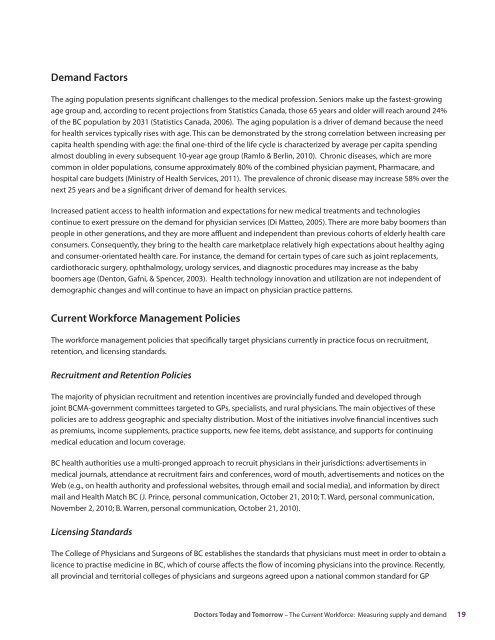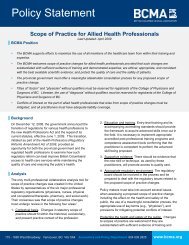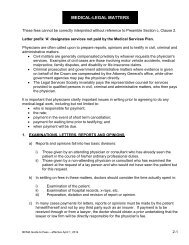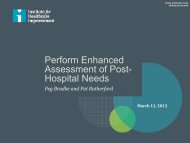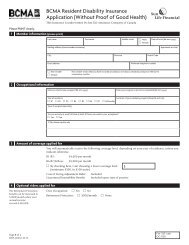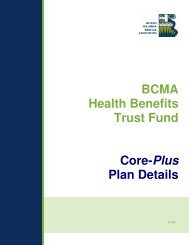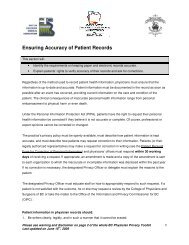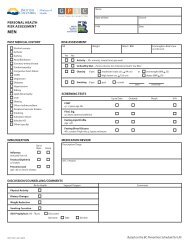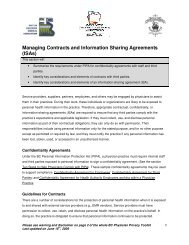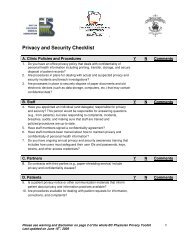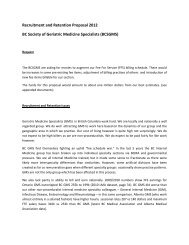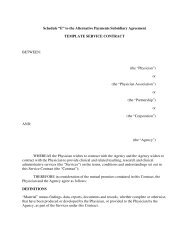Doctors Today and Tomorrow - British Columbia Medical Association
Doctors Today and Tomorrow - British Columbia Medical Association
Doctors Today and Tomorrow - British Columbia Medical Association
Create successful ePaper yourself
Turn your PDF publications into a flip-book with our unique Google optimized e-Paper software.
Dem<strong>and</strong> Factors<br />
The aging population presents significant challenges to the medical profession. Seniors make up the fastest-growing<br />
age group <strong>and</strong>, according to recent projections from Statistics Canada, those 65 years <strong>and</strong> older will reach around 24%<br />
of the BC population by 2031 (Statistics Canada, 2006). The aging population is a driver of dem<strong>and</strong> because the need<br />
for health services typically rises with age. This can be demonstrated by the strong correlation between increasing per<br />
capita health spending with age: the final one-third of the life cycle is characterized by average per capita spending<br />
almost doubling in every subsequent 10-year age group (Ramlo & Berlin, 2010). Chronic diseases, which are more<br />
common in older populations, consume approximately 80% of the combined physician payment, Pharmacare, <strong>and</strong><br />
hospital care budgets (Ministry of Health Services, 2011). The prevalence of chronic disease may increase 58% over the<br />
next 25 years <strong>and</strong> be a significant driver of dem<strong>and</strong> for health services.<br />
Increased patient access to health information <strong>and</strong> expectations for new medical treatments <strong>and</strong> technologies<br />
continue to exert pressure on the dem<strong>and</strong> for physician services (Di Matteo, 2005). There are more baby boomers than<br />
people in other generations, <strong>and</strong> they are more affluent <strong>and</strong> independent than previous cohorts of elderly health care<br />
consumers. Consequently, they bring to the health care marketplace relatively high expectations about healthy aging<br />
<strong>and</strong> consumer-orientated health care. For instance, the dem<strong>and</strong> for certain types of care such as joint replacements,<br />
cardiothoracic surgery, ophthalmology, urology services, <strong>and</strong> diagnostic procedures may increase as the baby<br />
boomers age (Denton, Gafni, & Spencer, 2003). Health technology innovation <strong>and</strong> utilization are not independent of<br />
demographic changes <strong>and</strong> will continue to have an impact on physician practice patterns.<br />
Current Workforce Management Policies<br />
The workforce management policies that specifically target physicians currently in practice focus on recruitment,<br />
retention, <strong>and</strong> licensing st<strong>and</strong>ards.<br />
Recruitment <strong>and</strong> Retention Policies<br />
The majority of physician recruitment <strong>and</strong> retention incentives are provincially funded <strong>and</strong> developed through<br />
joint BCMA-government committees targeted to GPs, specialists, <strong>and</strong> rural physicians. The main objectives of these<br />
policies are to address geographic <strong>and</strong> specialty distribution. Most of the initiatives involve financial incentives such<br />
as premiums, income supplements, practice supports, new fee items, debt assistance, <strong>and</strong> supports for continuing<br />
medical education <strong>and</strong> locum coverage.<br />
BC health authorities use a multi-pronged approach to recruit physicians in their jurisdictions: advertisements in<br />
medical journals, attendance at recruitment fairs <strong>and</strong> conferences, word of mouth, advertisements <strong>and</strong> notices on the<br />
Web (e.g., on health authority <strong>and</strong> professional websites, through email <strong>and</strong> social media), <strong>and</strong> information by direct<br />
mail <strong>and</strong> Health Match BC (J. Prince, personal communication, October 21, 2010; T. Ward, personal communication,<br />
November 2, 2010; B. Warren, personal communication, October 21, 2010).<br />
Licensing St<strong>and</strong>ards<br />
The College of Physicians <strong>and</strong> Surgeons of BC establishes the st<strong>and</strong>ards that physicians must meet in order to obtain a<br />
licence to practise medicine in BC, which of course affects the flow of incoming physicians into the province. Recently,<br />
all provincial <strong>and</strong> territorial colleges of physicians <strong>and</strong> surgeons agreed upon a national common st<strong>and</strong>ard for GP<br />
<strong>Doctors</strong> <strong>Today</strong> <strong>and</strong> <strong>Tomorrow</strong> – The Current Workforce: Measuring supply <strong>and</strong> dem<strong>and</strong> 19


